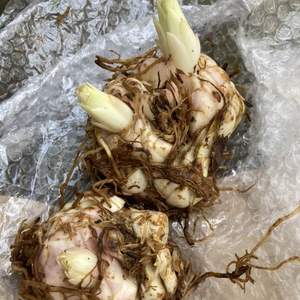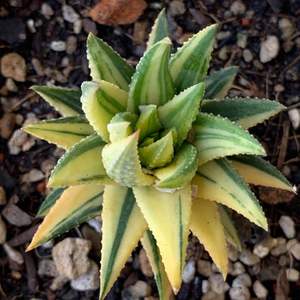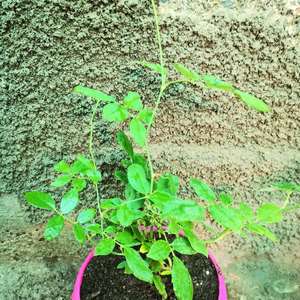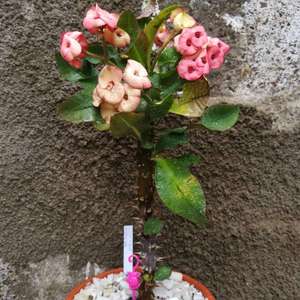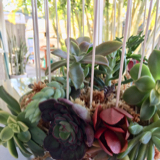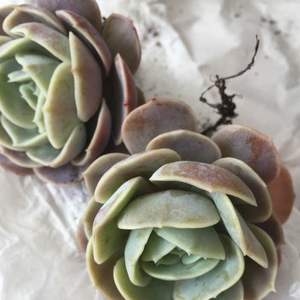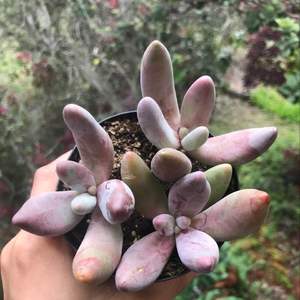Article
atastybellpepper
2022-07-04

A hybrid type of Lagerstroemia known most often as the crape (or crepe) myrtle, the Acoma crape myrtle is a member of the genus Lagerstroemia. This specific type is known to only grow to a height of around ten feet and is commonly described as remaining short in size and seeming more shrub-like than tree-like.
These plants are excellent choices for planting in suburban or urban areas. Due to its compact size, it is a great choice for gardens and lawns. It may also be used into a landscaping strategy for businesses. Additionally, this cultivar has increased resilience to powdery mildew, which certain crape myrtle plants often struggle with.
Name of the plant: Lagerstroemia x "Acoma"
Name of the plant: Lagerstroemia x "Acoma"
Plant Type Common Name Acoma Crape Myrtle 2 to 10 feet tall and 2 to 10 feet broad when fully grown
UV Radiation whole sun
Type of Soil Well-draining
pH of the Soil: Acidic to Neutral
Bloom Seasons Spring and summer
White Flower Hardiness Zones 7 to 9 Native Country Australia and Asia
How to Grow Crape Myrtle in Acoma
The cultivation of the Acoma crape myrtle is gratifying since it yields weeping branches covered in rich foliage and lovely blossoms. Although this cultivar needs a lot of sun, it thrives in a range of soil types and only need little water or fertilizer.
These trees are expected to grow at a medium pace, so you'll have plenty of time to observe their development. Just keep in mind that there won't be much more for you to do than observe; the Acoma crepe myrtle just needs its bottom branches sometimes pruned.
Light
Crape myrtle needs full light to flourish to its greatest capacity. Crape myrtles are well recognized for their stunning flowers, so to get the most out of the blossoming show, make sure they get at least six hours of light each day.
Soil The crape myrtle may grow in a variety of soil types, such as loam, clay, or sandy soils as long as the area has good drainage. These plants may thrive on slightly alkaline or slightly acidic soils, although they prefer slightly acidic to neutral pH values.
When the crape myrtle is initially planted, it has to be watered often until it becomes established. Once they reach maturity, however, these plants have little water requirements and may survive on about an inch of water per week.
Although they have shown to be comparatively drought-resistant, remember that a lack of water during bloom season may lead to a less impressive display. If you endure a prolonged dry spell and you don't want your flower output to suffer, try to supplement rainfall with routine watering.
Thermodynamics and Humidity
The Acoma crape myrtle thrives well even in hot areas and is tolerant of humidity or drought, like other crape myrtle kinds that flourish in the sun and heat.
On the other hand, it can often effectively resist temperatures as low as zero degrees Fahrenheit and is hardy in USDA zones 7 to 9.
Fertilizer
You may need to fertilize your crape myrtle to get the greatest blooms. Even while these plants may thrive in low-nutrient soil, they nevertheless need enough nitrogen to maintain bloom development.
Consider fertilizing your Acoma crape myrtle using a balanced formula, such as an 8-8-8 or 10-10-10, if your soil is deficient. The fertilizer may be administered at the beginning of the growth season and should be spread as soon as it rains, unless appropriate watering is provided subsequently.
While the proper quantity of fertilizer may bring out your crape myrtle's greatest qualities, an excessive amount might have the opposite effect. Don't overfeed your plants with fertilizers; doing so might result in excessive leaf growth and fewer blooms.
Acoma Crape Myrtle growth
Cuttings are the most effective method of propagating Acoma crape myrtle. Along with root cuttings, you may also employ soft or hardwood cuttings.
To reproduce from cuttings, use the following actions:
To remove hardwood or softwood cuts, use clean scissors or garden shears. Cuttings from hardwood should be roughly eight inches long. Once the tree has gone dormant for the year, usually in the late autumn, take hardwood cuttings. Softwood cuttings should grow around six inches long and have many nodes when they are taken in the spring or summer.
Leave approximately an inch of the cutting above the soil line when planting the cutting in a container filled with good potting soil.
Keep the soil wet, and place the container where it will get lots of sun. In approximately a month, softwood cuttings should start to grow again. Although they will develop more slowly, hardwood cuttings won't be ready for planting until the summer.
The cutting may be placed outside after it has established roots and begun to generate new growth. Place your new plant in an area with plenty of light and give it plenty of water.
Acoma Crape Myrtle toxicity
You may relax knowing that this tree will not hurt your dogs or other animals if you're worried about them nibbling on your crape myrtle. The Acoma crape myrtle is safe for both people and animals to consume.
Pruning
Light pruning may keep your Acoma crape myrtle looking excellent; it's best to do this in the spring before the heavy foliage covers the branches.
It won't need substantial pruning to maintain its height since this hybrid type is renowned for having a tiny shape, but you could wish to tidy up low branches to highlight the tree's lovely red-and-white smooth bark.
Additionally, pinching off new growth will urge your crape myrtle to grow fuller and bushier rather than higher, which will stimulate the tree to develop more branches. Remove wasted blooms as well to encourage more blossoming.
Typical Pests
One benefit of this hybrid species is greater resistance to powdery mildew, a disease that often affects crepe myrtle trees. Aphid infestation is still a problem for Acoma trees. This may result in a black mold, but it won't really endanger or harm the tree.
These plants are excellent choices for planting in suburban or urban areas. Due to its compact size, it is a great choice for gardens and lawns. It may also be used into a landscaping strategy for businesses. Additionally, this cultivar has increased resilience to powdery mildew, which certain crape myrtle plants often struggle with.
Name of the plant: Lagerstroemia x "Acoma"
Name of the plant: Lagerstroemia x "Acoma"
Plant Type Common Name Acoma Crape Myrtle 2 to 10 feet tall and 2 to 10 feet broad when fully grown
UV Radiation whole sun
Type of Soil Well-draining
pH of the Soil: Acidic to Neutral
Bloom Seasons Spring and summer
White Flower Hardiness Zones 7 to 9 Native Country Australia and Asia
How to Grow Crape Myrtle in Acoma
The cultivation of the Acoma crape myrtle is gratifying since it yields weeping branches covered in rich foliage and lovely blossoms. Although this cultivar needs a lot of sun, it thrives in a range of soil types and only need little water or fertilizer.
These trees are expected to grow at a medium pace, so you'll have plenty of time to observe their development. Just keep in mind that there won't be much more for you to do than observe; the Acoma crepe myrtle just needs its bottom branches sometimes pruned.
Light
Crape myrtle needs full light to flourish to its greatest capacity. Crape myrtles are well recognized for their stunning flowers, so to get the most out of the blossoming show, make sure they get at least six hours of light each day.
Soil The crape myrtle may grow in a variety of soil types, such as loam, clay, or sandy soils as long as the area has good drainage. These plants may thrive on slightly alkaline or slightly acidic soils, although they prefer slightly acidic to neutral pH values.
When the crape myrtle is initially planted, it has to be watered often until it becomes established. Once they reach maturity, however, these plants have little water requirements and may survive on about an inch of water per week.
Although they have shown to be comparatively drought-resistant, remember that a lack of water during bloom season may lead to a less impressive display. If you endure a prolonged dry spell and you don't want your flower output to suffer, try to supplement rainfall with routine watering.
Thermodynamics and Humidity
The Acoma crape myrtle thrives well even in hot areas and is tolerant of humidity or drought, like other crape myrtle kinds that flourish in the sun and heat.
On the other hand, it can often effectively resist temperatures as low as zero degrees Fahrenheit and is hardy in USDA zones 7 to 9.
Fertilizer
You may need to fertilize your crape myrtle to get the greatest blooms. Even while these plants may thrive in low-nutrient soil, they nevertheless need enough nitrogen to maintain bloom development.
Consider fertilizing your Acoma crape myrtle using a balanced formula, such as an 8-8-8 or 10-10-10, if your soil is deficient. The fertilizer may be administered at the beginning of the growth season and should be spread as soon as it rains, unless appropriate watering is provided subsequently.
While the proper quantity of fertilizer may bring out your crape myrtle's greatest qualities, an excessive amount might have the opposite effect. Don't overfeed your plants with fertilizers; doing so might result in excessive leaf growth and fewer blooms.
Acoma Crape Myrtle growth
Cuttings are the most effective method of propagating Acoma crape myrtle. Along with root cuttings, you may also employ soft or hardwood cuttings.
To reproduce from cuttings, use the following actions:
To remove hardwood or softwood cuts, use clean scissors or garden shears. Cuttings from hardwood should be roughly eight inches long. Once the tree has gone dormant for the year, usually in the late autumn, take hardwood cuttings. Softwood cuttings should grow around six inches long and have many nodes when they are taken in the spring or summer.
Leave approximately an inch of the cutting above the soil line when planting the cutting in a container filled with good potting soil.
Keep the soil wet, and place the container where it will get lots of sun. In approximately a month, softwood cuttings should start to grow again. Although they will develop more slowly, hardwood cuttings won't be ready for planting until the summer.
The cutting may be placed outside after it has established roots and begun to generate new growth. Place your new plant in an area with plenty of light and give it plenty of water.
Acoma Crape Myrtle toxicity
You may relax knowing that this tree will not hurt your dogs or other animals if you're worried about them nibbling on your crape myrtle. The Acoma crape myrtle is safe for both people and animals to consume.
Pruning
Light pruning may keep your Acoma crape myrtle looking excellent; it's best to do this in the spring before the heavy foliage covers the branches.
It won't need substantial pruning to maintain its height since this hybrid type is renowned for having a tiny shape, but you could wish to tidy up low branches to highlight the tree's lovely red-and-white smooth bark.
Additionally, pinching off new growth will urge your crape myrtle to grow fuller and bushier rather than higher, which will stimulate the tree to develop more branches. Remove wasted blooms as well to encourage more blossoming.
Typical Pests
One benefit of this hybrid species is greater resistance to powdery mildew, a disease that often affects crepe myrtle trees. Aphid infestation is still a problem for Acoma trees. This may result in a black mold, but it won't really endanger or harm the tree.
2
1
sososo: wow😯
Article
atastybellpepper
2022-07-04

Tree ivy (Fatshedera lizei) is a rare hybrid of two species from separate genera: Hedera helix and Fatsia japonica (glossy-leaved paper plant) (English ivy). The resultant hybrid features five-lobed English ivy leaves and the shrub-like form of a glossy-leaved paper plant. It has glossy, dark green evergreen leaves that may range in size from 4 to 10 inches. The perennial plant naturally forms a mound and has trailing branches, but it may be coaxed to grow into a tighter shrub shape by trimming. Although this plant is grown primarily for its foliage, it does produce tiny cream flowers in clusters in the fall. Tree ivy grows slowly, and the spring is the optimum season to plant it.
Care for Tree Ivy
Make careful to leave a minimum of 3 to 6 feet between each plant when you plant tree ivy outdoors. Choose a container with enough drainage holes for container development that is only slightly bigger than the root ball. If you want the plant to grow more like a vine, you will need to stake it or connect it to another kind of support, such a trellis, since it lacks the clinging capacity of genuine ivy. Alternately, you may just let it spread out as a ground cover.
Plan to routinely water, feed, and trim your tree ivy to keep it in the ideal form and size. Usually, the plant doesn't have any major insect or disease problems. Watch out for several common plant pests, such as aphids, mealybugs, and spider mites. 1 Make careful to look for evidence of the tiny insects on the undersides of leaves and to treat any infestations as soon as possible.
Light Dappled light is ideal for tree ivy growth. However, too little light may cause lanky, fragile stems and tiny, dull leaves. A location adjacent to a light window that is out of the direct sun is great for indoor growing.
The ideal soil for this plant is rich, loamy, with a pH range of slightly acidic to neutral and excellent drainage. For container growth, a light, all-purpose potting mix is acceptable.
Water
Even soil moisture is ideal for tree ivy, but persistently wet soil may damage the plant's roots.
1 When the soil starts to feel a little bit dry throughout the growth season (spring to autumn), water. Reduce watering throughout the winter months when the plant has gone dormant in order to keep the soil from entirely drying up. Leaf drop and yellowing of the leaves are two possible symptoms of overwatering in tree ivy.
Thermodynamics and Humidity
The ideal temperature range for tree ivy to flourish is between 50 and 70 degrees Fahrenheit. In warmer locations, it's crucial to provide a tree ivy plant shade and enough water since excessive heat may lead to leaf drop and eventually kill the plant. Although the plant may tolerate some cold, it can die back at temperatures below 20 degrees Fahrenheit. 1 When warm weather returns, the plant may still reappear from its roots if the temperature doesn't drop too much.
Additionally, tree ivy prefers a moderate to high humidity level. To increase the humidity surrounding a container plant, set it on a tray with water and stones. The plant might benefit from regular spraying to help increase the humidity to its preferred level. When exposed to dry air for an extended period of time, tree ivy plants' leaves might become brown and fall off.
Fertilizer
Tree ivy may feed from moderately to heavily. Feed your plant with a houseplant fertilizer throughout the growth season, as directed on the package. In the winter, fertilizer is not required.
Tree ivy may be lightly pruned at any time to shape it anyway you choose. And if it isn't pruned, it may begin to seem unkempt. Pinch off new growth on the stems to encourage the bushier growth habit that many gardeners like, particularly for houseplants. More branches will result as a result.
Developing Tree Ivy
Tree ivy plants are sterile, hence it is impossible to cultivate it from seed. However, stem cuttings are a rather simple method of propagation. Just cut off a section of the stem that is about 6 inches long. After removing the lower half's leaves and injecting rooting hormone into the cut end, place the plant in a soilless potting mixture. Keep the growth medium wet and the cutting in a warm area with indirect light (but not soggy). As soon as you can gently pull on the stem and experience resistance, you'll know it has established roots.
Variety of Tree Ivy
Tree ivy comes in a number of kinds with different leaf shapes and sizes:
A 6-foot-tall cultivar of Fatshedera lizei called "Variegata" has leaves with cream-colored borders.
The leaves of x Fatshedera lizei 'Curly' are unusually curled.
A shorter (4-foot) variation of x Fatshedera lizei called "Ribbon Candy" has wavy leaves that have a pale green tint. It grows well as a shrubby plant. The 8-foot-tall form of Fatshedera lizei known as "Annemieke" has large leaves with yellow patterns.
Care for Tree Ivy
Make careful to leave a minimum of 3 to 6 feet between each plant when you plant tree ivy outdoors. Choose a container with enough drainage holes for container development that is only slightly bigger than the root ball. If you want the plant to grow more like a vine, you will need to stake it or connect it to another kind of support, such a trellis, since it lacks the clinging capacity of genuine ivy. Alternately, you may just let it spread out as a ground cover.
Plan to routinely water, feed, and trim your tree ivy to keep it in the ideal form and size. Usually, the plant doesn't have any major insect or disease problems. Watch out for several common plant pests, such as aphids, mealybugs, and spider mites. 1 Make careful to look for evidence of the tiny insects on the undersides of leaves and to treat any infestations as soon as possible.
Light Dappled light is ideal for tree ivy growth. However, too little light may cause lanky, fragile stems and tiny, dull leaves. A location adjacent to a light window that is out of the direct sun is great for indoor growing.
The ideal soil for this plant is rich, loamy, with a pH range of slightly acidic to neutral and excellent drainage. For container growth, a light, all-purpose potting mix is acceptable.
Water
Even soil moisture is ideal for tree ivy, but persistently wet soil may damage the plant's roots.
1 When the soil starts to feel a little bit dry throughout the growth season (spring to autumn), water. Reduce watering throughout the winter months when the plant has gone dormant in order to keep the soil from entirely drying up. Leaf drop and yellowing of the leaves are two possible symptoms of overwatering in tree ivy.
Thermodynamics and Humidity
The ideal temperature range for tree ivy to flourish is between 50 and 70 degrees Fahrenheit. In warmer locations, it's crucial to provide a tree ivy plant shade and enough water since excessive heat may lead to leaf drop and eventually kill the plant. Although the plant may tolerate some cold, it can die back at temperatures below 20 degrees Fahrenheit. 1 When warm weather returns, the plant may still reappear from its roots if the temperature doesn't drop too much.
Additionally, tree ivy prefers a moderate to high humidity level. To increase the humidity surrounding a container plant, set it on a tray with water and stones. The plant might benefit from regular spraying to help increase the humidity to its preferred level. When exposed to dry air for an extended period of time, tree ivy plants' leaves might become brown and fall off.
Fertilizer
Tree ivy may feed from moderately to heavily. Feed your plant with a houseplant fertilizer throughout the growth season, as directed on the package. In the winter, fertilizer is not required.
Tree ivy may be lightly pruned at any time to shape it anyway you choose. And if it isn't pruned, it may begin to seem unkempt. Pinch off new growth on the stems to encourage the bushier growth habit that many gardeners like, particularly for houseplants. More branches will result as a result.
Developing Tree Ivy
Tree ivy plants are sterile, hence it is impossible to cultivate it from seed. However, stem cuttings are a rather simple method of propagation. Just cut off a section of the stem that is about 6 inches long. After removing the lower half's leaves and injecting rooting hormone into the cut end, place the plant in a soilless potting mixture. Keep the growth medium wet and the cutting in a warm area with indirect light (but not soggy). As soon as you can gently pull on the stem and experience resistance, you'll know it has established roots.
Variety of Tree Ivy
Tree ivy comes in a number of kinds with different leaf shapes and sizes:
A 6-foot-tall cultivar of Fatshedera lizei called "Variegata" has leaves with cream-colored borders.
The leaves of x Fatshedera lizei 'Curly' are unusually curled.
A shorter (4-foot) variation of x Fatshedera lizei called "Ribbon Candy" has wavy leaves that have a pale green tint. It grows well as a shrubby plant. The 8-foot-tall form of Fatshedera lizei known as "Annemieke" has large leaves with yellow patterns.
1
1
sososo: thanks😘
Linda's Garden
2020-07-12
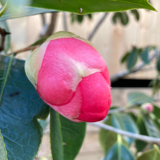
Lily LA Hybrid-Merlet
Strong & pretty lily bulbs, vintage pink color, bloom earlier in spring, can grow up to 1 meter. Hope it will folwer as beautiful as seller’s showing.
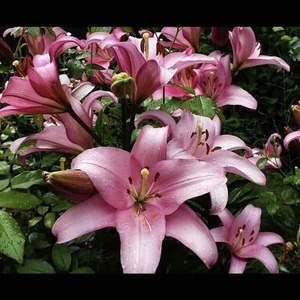
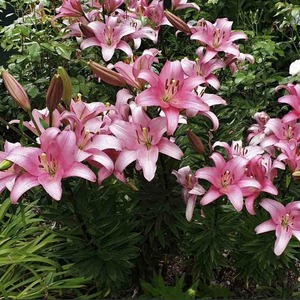
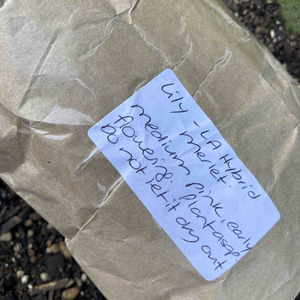
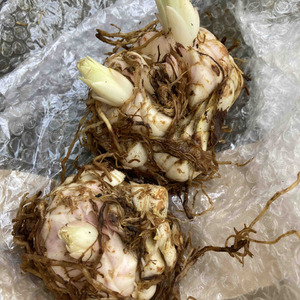
Strong & pretty lily bulbs, vintage pink color, bloom earlier in spring, can grow up to 1 meter. Hope it will folwer as beautiful as seller’s showing.




0
0
Growing
kensong
2019-05-01

The hybrid Ficus Lyrata Variegata is not an easy find and also not an easy plant to care for compared to the regular FLF but it's such a beauty.
It's leaves look painted with a cream white that frames a forest green leaf with unpredictable patches of olive green intertwined.
#ficus #ficuslyrata #ficuslyratavariegata #ficuslyratavariegated #lyrata #rubberplant #rubberplants #variegated #variegatedplants #houseplants #gardening #gardening_love #betterhomesandgardens #urbanplants
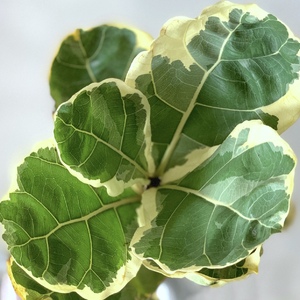
It's leaves look painted with a cream white that frames a forest green leaf with unpredictable patches of olive green intertwined.
#ficus #ficuslyrata #ficuslyratavariegata #ficuslyratavariegated #lyrata #rubberplant #rubberplants #variegated #variegatedplants #houseplants #gardening #gardening_love #betterhomesandgardens #urbanplants

1
0
Growing
Animalover080
2019-04-29

I now added "Golden Glow Stonecrop / Sedum Hybrid" in my "garden"
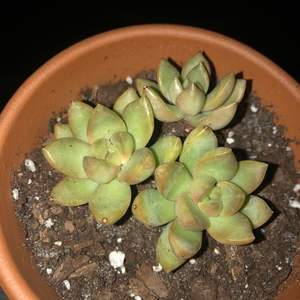

0
0
Growing
kensong
2019-03-20

My Aloe Pink Blush flowered and it's flaming red. It is one of the prettier Aloe hybrid and is a forgiving plant especially great for beginners. This is the second time it has flowered and a pup is making its appearance too.


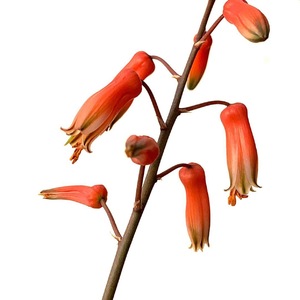



0
0
Growing
monsterick
2019-01-10

I Nuevo agregado un Crassula mesembryanthemopsis x falcata hybrid (Morgan's Beauty) en mi jardín
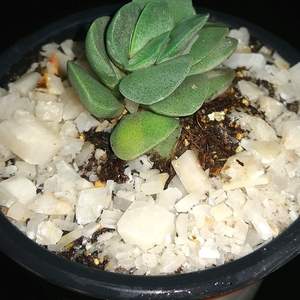

0
0


